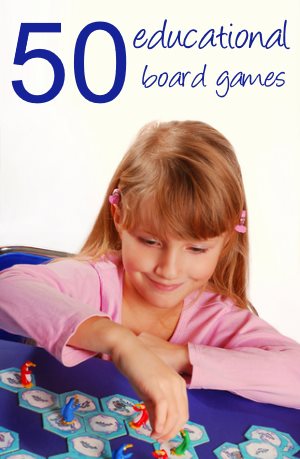Raising Butterflies
A Butterfly Life Cycle Indoors
There is no better way for kids to understand a butterfly life cycle than by keeping caterpillars indoors. This makes a great homeschool science project.
Learn about finding caterpillars, identification and caterpillar food - then let nature do the rest!
Watching caterpillars change into butterflies is a great way to introduce kids to metamorphosis. They will love watching this life cycle play out in front of them.Raising butterflies is easy to do - we have raised them almost every year since my daughter was small. Here are my tips and techniques for some sucessful homeschool science.
The first thing you need to do is find your caterpillar! Once you know what you are looking for then they are quite easy to spot.
The best place to look is on your caterpillars favourite food. You may find eggs on cabbage leaves, or look out for caterpillar nests. Nests are either made by folding leaves up to make a parcel, or by using a spider web type material.
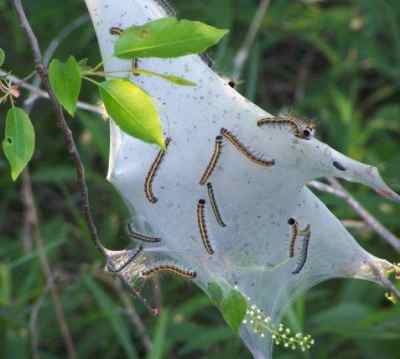
In the UK, stinging nettles are a great place to look. Look the plants over carefully for a leaf that looks folded in two and sealed. If you gently prise the leaf open and peek inside you will usually find the little black caterpillars of the Small Tortoiseshell butterfly.
In the US and Australia you can find Painted Lady caterpillars in nests on thistle, mallow, and hollyhock. They also fold up the leaves but use a mass of 'web' to seal them.
Keep your eyes open, and ask around. Gardeners often come across caterpillars and are usually helpful in spotting them. We met an entomologist who kindly brought us a Hawkmoth caterpillar he had found.
If you find a nest, don't forget to take a photograph and share with us how you found it!
Still can't find one? There are several places online where you can buy kits for raising butterflies. Try these pavillions :
| US | US | UK | ||
|---|---|---|---|---|
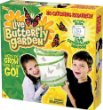 |  |  |
In order to look after your caterpillar properly, it is helpful to identify it. Use books, or the internet to check out your find. Your caterpillar will generally want to eat the plant you found it on but it is best to check.
Most chrysalis is formed on twigs or branches of plants, but some caterpillars (like that of the Hawkmoth) bury themselves in the ground for their metamorphosis, and don't hatch until the following year. This type of caterpillar will need soil at the bottom of it's container.
| US | US | UK | ||
|---|---|---|---|---|
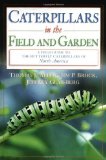 | 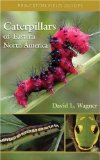 |  |
Your caterpillar will be comfortable enough in a large glass jar, as long as you keep it out of direct sunlight. Add some of plants for food and some twigs for your caterpillar to climb on.
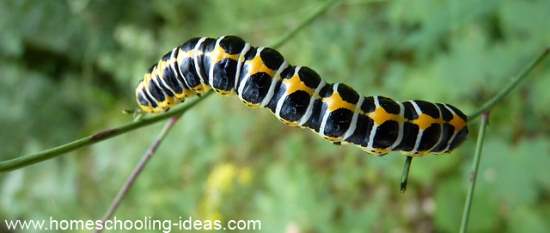
You will need to add fresh food every day - and to clean out the jar every two or three days. I usually tip out the contents of the jar onto newspaper, then gently return the caterpillar into the jar filled with fresh leaves and twigs. Most smooth caterpillars are safe to handle - the hairy ones can often cause irritation. Do identify it as safe to handle before you let the children touch it.
It is fun to extend your homeschooling raising butterflies project by making a meal out of caterpillar food! Try this Stinging Nettle Soup Recipe or look for a cabbage recipe to try. |
When your caterpillar is ready to turn into a chrysalis, it will climb as high as it can in its home - and curl itself up. It will then turn into a chrysalis. Put your jar in a quiet place and try not to disturb it.
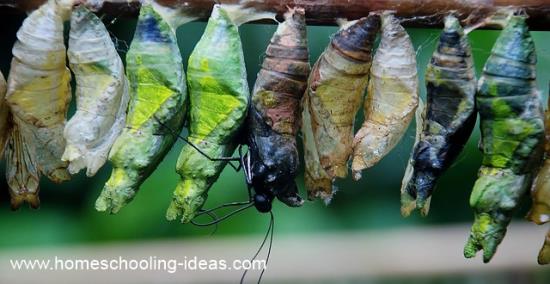
You can feed your butterfly some sugar water before letting it go free. Dissolve 1 tablespoon of sugar into 10 tablespoons of warm water. You can place this near the butterfly either in an upturned jar lid - or by soaking a small sponge. You could also add flowers or fruit to the jar.
Release your butterfly gently near a flower patch.
Watching the butterfly life cycle is a wonderful thing to do with children. Why not make raising butterflies part of your homeschool science every year?
Would you like some lesson plans? Try these science project ideas from Glorious-Butterfly.com.
Another fun activity is to make a butterfly life cycle flip book.

Found a Caterpillar?
Why not share?
Raising a butterfly as part of your homeschooling science? Why not share and help other readers?
It would be really helpful if you could send a photo of your caterpillar and it's nest. Where did you find it? Where should others look? What signs should people be looking for?.
What other butterfly help have people shared?
Click below to see other stories about finding and raising butterflies.
It was a moth!!!! 




For several years now we have been hatching moths.
We regularily find fat green caterpillars in our garden eating the flowers of our spring flowering …
Beautiful Monarch Butterflies 




The Monarch caterpillar loves to eat the flowers from the Milkweed plant. The children plant it every spring and summer .
They take …
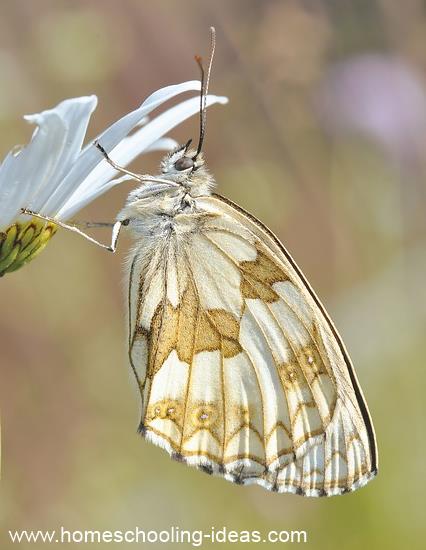
Lovely messages sent from visitors like you:
Oh my goodness! I am a home schooling mum of 4 and I have NEVER found a better site! Thank you so much.
Blessings, Jenny (New Zealand)
I wanted to say THANK YOU for your fabulous website. I found your website, and finally I have the confidence to take the plunge and take my daughter out of school and educate her at home, thank you, thank you.
Marina (UK)
I cannot get over how much great information and super ideas you have here. Fantastic!
Ruralmama (USA)
This is simply fabulous!! I just now found this site and I'm so excited!! The opportunities and suggestions as well as the need to inspire are exactly what I have been searching to fulfill!! I'm so thrilled to get started and even more excited to continue to explore all of the fabulous suggestions and creative ideas you have offered here!!! Thank you, thank you, thank you!
Jennifer (USA)







